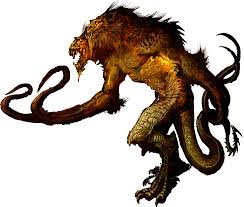When setting out into the depths of The Gloom, a party might need to hire extra help or supplies to aid in their travels, and to bolster their forces. These creatures (referred to as Hirelings from this point on) receive no share of the treasure, do not level up and are not under the control of players directly – if asked to do something dangerous a loyalty check will determine whether they comply. As such, they have their own motivations, fears and limits. They do not receive death saves. They will supply their own equipment but not their own supplies which the party must pay for. Each PC may only have a single hireling per expedition.
Loyalty Check
Each hireling must make a loyalty check if their resolve or loyalty is tested. This is a D20 roll which must roll below their loyalty score in order to pass. (For example, if a Mercenary has a Loyalty Score of 15, a roll of 14 would pass but 16 would not.) If a loyalty test is failed the character’s loyalty will decrease for that expedition and they will refuse to take that action, or may flee the danger. Success and good treatment will increase a character’s loyalty.
Pack Animals and War-Animals
Pack Animals are used to increase a party’s effective carrying capacity or bolster their forces. They will require one food and one water ration a day just like a player-character. Animals do not eat normal Food Rations but instead eat cheaper Animal Feed (1EU, 1 SP). (Stat blocks at end of article.)
The Animal Handling skill is used to interact with animals and ensure they follow instructions.
Unlike other hirelings, animals are owned by the character once bought.
Animal
|
Cost
|
Loyalty
|
Mule – a surefooted
and stubborn pack-mule. (Mule)
|
30
|
15
|
Guard Dog – man’s
best friend, even in The Gloom.
(Mastiff)
|
30
|
18
|
Messenger Owl – It
can carry your last words through the dark on silent wings. (Owl)
|
10
|
8
|
Hirelings
These are people who will offer their services to adventurers, but they are themselves not accustomed to combat and will be little use in a fight. For a price, they will venture into The Gloom to aid you but they will avoid being put in harm’s way wherever possible. Use the Commoner stats should they be attacked.
Hireling
|
Wage per Day
|
Loyalty
|
Torchbearer – he will
carry your torch and your bags, leaving your hands free. He will watch over you while you sleep.
|
10
|
10
|
Sage – A wise and
learned figure who can offer knowledge at critical junctures.
|
15
|
8
|
Barber-Surgeon – This
figure can splint bones and prepare a poultice for your wounds.
|
20
|
10
|
Sherpa – He has
knowledge of survival, and many tales of the dangers of the Gloom to offer.
|
20
|
10
|
Mercenaries
Some people fight and kill for money – a well-remunerated skill-set in the wilds of The Gloom. Mercenaries will fight in the melee for you but will flee if the danger is too great.
For each mercenary hired, your DM will roll on the Random Adventurers table to generate their stats.
Some people fight and kill for money – a well-remunerated skill-set in the wilds of The Gloom. Mercenaries will fight in the melee for you but will flee if the danger is too great.
For each mercenary hired, your DM will roll on the Random Adventurers table to generate their stats.
Hireling
|
Wage per Day
|
Loyalty
|
Mercenary
|
30
|
16
|






















